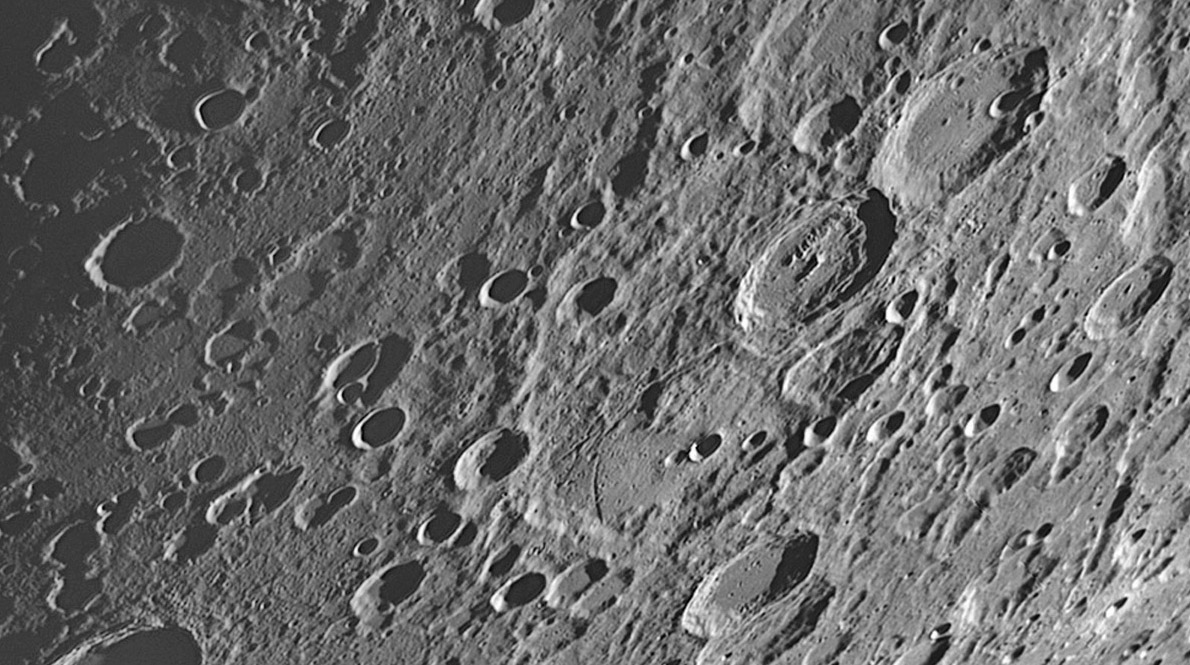Difference between revisions of "May 21, 2010"
| (2 intermediate revisions by the same user not shown) | |||
| Line 6: | Line 6: | ||
<em>image by [mailto:astrovign@hotmail.com Giancarlo Vignale], Sanremo, Italy</em><br /> | <em>image by [mailto:astrovign@hotmail.com Giancarlo Vignale], Sanremo, Italy</em><br /> | ||
<br /> | <br /> | ||
| − | This broad area of the southeast quadrant of the Moon is dominated by one event - the formation of the Nectaris Basin. The most prominent basin rim is out of the image to the north (top) but a lyer of ejecta coats much of the surface between the craters. The right edge of the image is framed by the [ | + | This broad area of the southeast quadrant of the Moon is dominated by one event - the formation of the Nectaris Basin. The most prominent basin rim is out of the image to the north (top) but a lyer of ejecta coats much of the surface between the craters. The right edge of the image is framed by the [https://the-moon.us/wiki/Rükl_68 Rheita Valley], which abruptly bends near the sharp crater [https://the-moon.us/wiki/file/detail/Rukl_68_satellites_SE.jpg Young B] at right center. The Valley is the most prominent group of secondary craters from the basin, but other singlets, pairs and triples are widespread - they typically have interlocking rims with flat floors - look closely at the western third of the area. It is perplexing that some of these secondary crater floors are smoother than the rough textured surrounding terrain, which is dominated by Nectaris ejecta. It is hard to understand why there is smooth material on the floors but not on the surroundings - could the craters have somehow captured a different, more powdery phase of ejecta? I don't see how. The largest feature here was also effected by Nectaris. The smooth floor of Janssen is also probably smooth Nectaris ejecta, as may be the rougher textured material near the crater's center and north, although part may be debris from the overlapping Fabricius. Keep looking around for every image has many stories to tell.<br /> |
<br /> | <br /> | ||
<em>[mailto:tychocrater@yahoo.com Chuck Wood]</em><br /> | <em>[mailto:tychocrater@yahoo.com Chuck Wood]</em><br /> | ||
| Line 14: | Line 14: | ||
<br /> | <br /> | ||
<strong>Related Links</strong><br /> | <strong>Related Links</strong><br /> | ||
| − | Rükl plate [ | + | Rükl plate [https://the-moon.us/wiki/R%C3%BCkl67 67]<br /> |
<br /> | <br /> | ||
<hr /> | <hr /> | ||
<table class="wiki_table"> | <table class="wiki_table"> | ||
<tr> | <tr> | ||
| − | <td><!-- | + | <td> <!-- RemoveRevolverMaps --> |
| − | + | <!-- RemoveRevolverMaps --> | |
| + | </td> | ||
<p><b>Yesterday's LPOD:</b> [[May 20, 2010|Heavenly Hevelius]] </p> | <p><b>Yesterday's LPOD:</b> [[May 20, 2010|Heavenly Hevelius]] </p> | ||
<p><b>Tomorrow's LPOD:</b> [[May 22, 2010|Sequencing History]] </p> | <p><b>Tomorrow's LPOD:</b> [[May 22, 2010|Sequencing History]] </p> | ||
| − | |||
<!-- End of content --> | <!-- End of content --> | ||
{{wiki/ArticleFooter}} | {{wiki/ArticleFooter}} | ||
Latest revision as of 19:54, 18 August 2018
Dominated

image by Giancarlo Vignale, Sanremo, Italy
This broad area of the southeast quadrant of the Moon is dominated by one event - the formation of the Nectaris Basin. The most prominent basin rim is out of the image to the north (top) but a lyer of ejecta coats much of the surface between the craters. The right edge of the image is framed by the Rheita Valley, which abruptly bends near the sharp crater Young B at right center. The Valley is the most prominent group of secondary craters from the basin, but other singlets, pairs and triples are widespread - they typically have interlocking rims with flat floors - look closely at the western third of the area. It is perplexing that some of these secondary crater floors are smoother than the rough textured surrounding terrain, which is dominated by Nectaris ejecta. It is hard to understand why there is smooth material on the floors but not on the surroundings - could the craters have somehow captured a different, more powdery phase of ejecta? I don't see how. The largest feature here was also effected by Nectaris. The smooth floor of Janssen is also probably smooth Nectaris ejecta, as may be the rougher textured material near the crater's center and north, although part may be debris from the overlapping Fabricius. Keep looking around for every image has many stories to tell.
Chuck Wood
Technical Details
19 Aprile 2010 h 20:30-22:00. Meade 2120 da 10" e 2800mm. di focale con filtro rosso e camera Image Source DMK31AU.AS03 filmati da 2 minuti.
Related Links
Rükl plate 67
Yesterday's LPOD: Heavenly Hevelius
Tomorrow's LPOD: Sequencing History
COMMENTS?
Register, Log in, and join in the comments.



